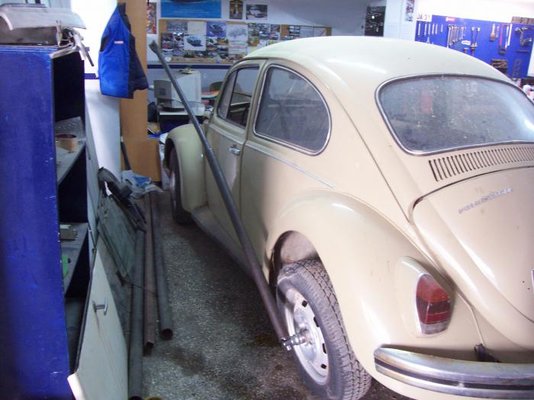mike4gtl
Mad many would insit upon
- Messages
- 794
So I have finally finished rebuilding the drive shafts on the Traction and am almost satisfied with them. Its not a job I would wish on anyone and would even think twice about doing a pair again myself. (Although I probably would do it differently :eek If I ever write a biography I would be sure to mention them.
If I ever write a biography I would be sure to mention them.
Its taken me just over 100 hours and I have found that there is no point even attempting to try and attack them without a large press, an oxy-acetylene kit, a set of large Inch drive sockets, a 4 foot lever bar (inch drive) and (if you haven't the correct outer wheel bearing spanner) a 4 foot long monkey wrench, Reason being is the outer nut is done up do an insane of pounds feet.
However before you can even begin to dismantle the shafts you have to get the brake drums off. This is where all the trouble began and there were three of us scratching our heads.
The drum is not like a ‘normal’ drum for starters its in two pieces and instead of it attaching to a hub like a Renault 4, it attaches to the end of the three foot long drive shaft, then the wheel bolts to the drum. It is held in place by a locating keyway and a big taper. (Drums tapered too). Getting the nut off is not to hard with big tools, however separating the drum from the taper is immensely hard and I mean temper fraying hard.
This is where the gas axe comes in handy and I know you’re not supposed to head cast iron until its cherry red but I did – it had to come off in my eyes. Citroen said all those years ago that your supposed to use a puller – ok fair enough – then when you look at the size of it (and you can still buy these pullers) well they wouldn’t pull your cap off.
So rummaging around at work I found a mini flywheel puller and a Jaguar rear hub puller. I cobbled the two together and made myself a proper tool for the job, I then clamped this around the lip on the drum Citroen kindly provide you with, gave it a bit more heat and with a couple of taps with a mallet off it popped finally.
I had the same battle with the other side. In the meantime I am worrying about melting the wheel cylinder rubbers so just incase I have bought two rebuild kits and new hoses. This means the drums will be coming off again at some point in the near future.
You can now wiggle and swear a lot and withdraw the shaft ready to replace all the six UJ’s. The larger two with the hole through the middle are a pain, as you have to try and hold the whole assembly whilst tilting the yoke just enough in order for it to simply just slip in. Then you can tap/press in the caps and rollers.
The manual was very helpful providing you carry out the modifications it recommends and re-solder the inner cardan balls ‘gimbals’ correctly (I had a lot of trouble here).
I will post some pictures of this trauma shortly. In the meantime this will make you all laugh.
As I want to preserve it in its original condition and not weld it, last night before I bought it home I decided to fill the sills and body with waste engine oil. I removed the inspection plate on the ‘Jamboneaux’ to find a nice big section I could pour oil straight into, so I start tipping oil in, lovely and I am over the moon because I know I am doing it the world off good (maybe not the actual world though I realize).
I empty just over a litre in each side and it disappears. No oil comes out of the body, so I pour in another. Again it drains away. My friend suggests I stick the airline in there to blow it down the sills to the rear, Good Idea. That done still no leaks so I figure it’s all now nicely swimming in oil. I reverse it off the ramp and park it up (its now 11.30pm) wash my hands and drive home feeling pleased.
I awoke this morning to a BIG trail of black oil up my road and into my drive and a huge puddle where I parked over night. :shock: Hmmm I’m thinking, how do I clean this up…… photos to follow
 If I ever write a biography I would be sure to mention them.
If I ever write a biography I would be sure to mention them.Its taken me just over 100 hours and I have found that there is no point even attempting to try and attack them without a large press, an oxy-acetylene kit, a set of large Inch drive sockets, a 4 foot lever bar (inch drive) and (if you haven't the correct outer wheel bearing spanner) a 4 foot long monkey wrench, Reason being is the outer nut is done up do an insane of pounds feet.
However before you can even begin to dismantle the shafts you have to get the brake drums off. This is where all the trouble began and there were three of us scratching our heads.
The drum is not like a ‘normal’ drum for starters its in two pieces and instead of it attaching to a hub like a Renault 4, it attaches to the end of the three foot long drive shaft, then the wheel bolts to the drum. It is held in place by a locating keyway and a big taper. (Drums tapered too). Getting the nut off is not to hard with big tools, however separating the drum from the taper is immensely hard and I mean temper fraying hard.
This is where the gas axe comes in handy and I know you’re not supposed to head cast iron until its cherry red but I did – it had to come off in my eyes. Citroen said all those years ago that your supposed to use a puller – ok fair enough – then when you look at the size of it (and you can still buy these pullers) well they wouldn’t pull your cap off.
So rummaging around at work I found a mini flywheel puller and a Jaguar rear hub puller. I cobbled the two together and made myself a proper tool for the job, I then clamped this around the lip on the drum Citroen kindly provide you with, gave it a bit more heat and with a couple of taps with a mallet off it popped finally.
I had the same battle with the other side. In the meantime I am worrying about melting the wheel cylinder rubbers so just incase I have bought two rebuild kits and new hoses. This means the drums will be coming off again at some point in the near future.
You can now wiggle and swear a lot and withdraw the shaft ready to replace all the six UJ’s. The larger two with the hole through the middle are a pain, as you have to try and hold the whole assembly whilst tilting the yoke just enough in order for it to simply just slip in. Then you can tap/press in the caps and rollers.
The manual was very helpful providing you carry out the modifications it recommends and re-solder the inner cardan balls ‘gimbals’ correctly (I had a lot of trouble here).
I will post some pictures of this trauma shortly. In the meantime this will make you all laugh.
As I want to preserve it in its original condition and not weld it, last night before I bought it home I decided to fill the sills and body with waste engine oil. I removed the inspection plate on the ‘Jamboneaux’ to find a nice big section I could pour oil straight into, so I start tipping oil in, lovely and I am over the moon because I know I am doing it the world off good (maybe not the actual world though I realize).
I empty just over a litre in each side and it disappears. No oil comes out of the body, so I pour in another. Again it drains away. My friend suggests I stick the airline in there to blow it down the sills to the rear, Good Idea. That done still no leaks so I figure it’s all now nicely swimming in oil. I reverse it off the ramp and park it up (its now 11.30pm) wash my hands and drive home feeling pleased.
I awoke this morning to a BIG trail of black oil up my road and into my drive and a huge puddle where I parked over night. :shock: Hmmm I’m thinking, how do I clean this up…… photos to follow





